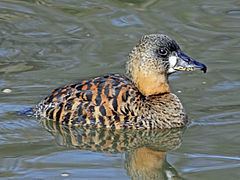Scientific name Thalassornis leuconotus Higher classification Thalassornis | Phylum Chordata Rank Species | |
 | ||
Subfamily ThalassorninaeLivezey, 1986 Genus ThalassornisEyton, 1838 Similar Bird, Anatidae, Spur‑winged goose, African pygmy goose, Red‑billed teal | ||
White backed duck family
The white-backed duck (Thalassornis leuconotus) is a waterbird of the family Anatidae. It is distinct from all other ducks, but most closely related to the whistling ducks in the subfamily Dendrocygninae, though also showing some similarities to the stiff-tailed ducks in the subfamily Oxyurinae. It is the only member of the genus Thalassornis.
Contents
- White backed duck family
- White backed duck and chick
- Description
- Distribution and habitat
- Subspecies
- Conservation
- References
White backed duck and chick
Description
These birds are well adapted for diving. On occasions they have been observed to stay under water for up to half a minute. They search especially for the bulbs of waterlilies, but also seeds and leaves of waterlilies and other water plants and the young feed on lake flies larvae as well. From danger, they also escape preferentially by diving; hence, the namesake white back is hardly visible in life.
Distribution and habitat
White-backed ducks live in southern Africa, especially between Senegal and Chad in the west and Ethiopia and South Africa in the east. Their habitat consists of lakes, ponds, swamps and marshes where they are well camouflaged against predators.
Subspecies
There are two subspecies, Thalassornis leuconotus leuconotus and Thalassornis leuconotus insularis. The latter lives entirely on Madagascar and is considered to be endangered by hunting, habitat loss and the introduction of competing exotic species.
Conservation
The white-backed duck is one of the species to which the Agreement on the Conservation of African-Eurasian Migratory Waterbirds (AEWA) applies.
Woolaver and Nichols conducted a nesting survey of the Madagascar race in 2001 at Lake Antsamaka in western Madagascar. They found a total of 37, indicating the significance of this single site for the conservation of this insular subspecies. Young, et al. (2006) suggested that an earlier population estimate of 2,500–5,000 total birds in Madagascar by Delany and Scott may be too optimistic. Its African population may be in the range of 10,000 to 25,000 birds.
